System Analysis
- The systems that we are talking about are the systems within organizations and businesses - systems of communication, financial systems, manufacturing systems, etc. - basically the systems that make the organization or business work.
- A person who analyses systems is known as a Systems Analyst.
- Often systems analysts are employed by organizations of businesses to help them improve their systems and so become more efficient, and for businesses, more profitable.
- Before the systems analyst can make any recommendations about a new system, they first have to understand how the present system works.
Collecting Information
As much information about the present system needs to be gathered as possible. The system analyst can use a number of techniques:-Observation
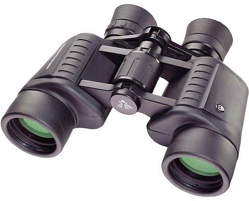 This involves the systems analyst walking around the organization or business, watching how things work with his/her own eyes.
This involves the systems analyst walking around the organization or business, watching how things work with his/her own eyes.Observation allows the systems analyst to gather first-hand, unbiased information.
The downside to observation is that often people won't work the way they normally do if they know they are being watched.
Interviews
The systems analyst can interview key people within the system to find out how it works.
Interviews allow lots of very detailed information to be gathered, but they take a long time to do, so are not possible if large groups of people are involved.
Interviews allow lots of very detailed information to be gathered, but they take a long time to do, so are not possible if large groups of people are involved.
Questionnaires
 With large groups of people, a questionnaire is a quick and simple way to gather information.
With large groups of people, a questionnaire is a quick and simple way to gather information. However the information gathered is limited by the questions set by the systems analyst (people could have a lot of useful information in their heads, but if the questionnaire doesn’t ask the right questions, they will not be able to pass it on)
Also many people do not take the time to fill in questionnaires seriously.
Collecting Documents
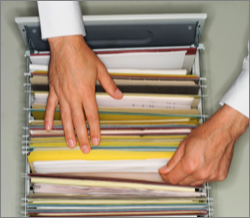 Most businesses and organizations use documents to record information, or to communicate information (forms get filled in and passed to other offices, etc.)
Most businesses and organizations use documents to record information, or to communicate information (forms get filled in and passed to other offices, etc.)
The systems analyst needs to collect examples of the documents used to get an understanding of the type and quantity of data that flows through the business or organization.
Having collected as much information about the present system as possible, the systems analyst now looks though it all to understand how the system works, and to try and identify problems that need to be fixed. This process is called analysis.
Identifying the Inputs, Outputs and Processes
Every system has inputs and outputs and the systems analyst needs to identify the data input to the present system, and the data output.
For example, the payroll system in a business might have the following inputs and outputs...
For example, the payroll system in a business might have the following inputs and outputs...
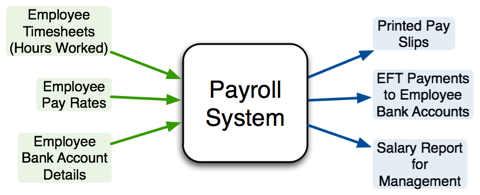
Any new system that is created will need to take in the same input data (the number of hours worked by employees), and will have to produce the same three outputs.
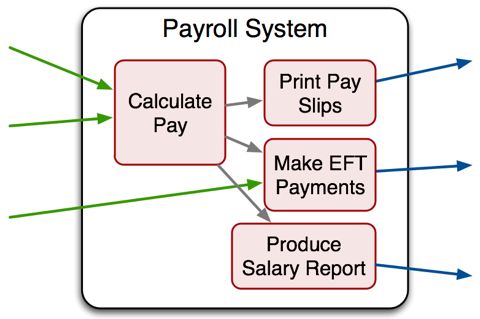
Identifying Problems
No system is perfect and it is the job of the systems analyst to try and identify where the problems in a system are.
If these problems can be fixed, the system will work more smoothly, be more efficient and, in the case of a business, be more profitable.
In the above payroll example, the following problems might be identified
If these problems can be fixed, the system will work more smoothly, be more efficient and, in the case of a business, be more profitable.
In the above payroll example, the following problems might be identified
- The payroll often takes over three days to process, resulting in many employees being paid late
- Timesheets sometimes get lost before being processed. This means that sometimes pay has to be estimated
- The reports sent to management do not show enough information.
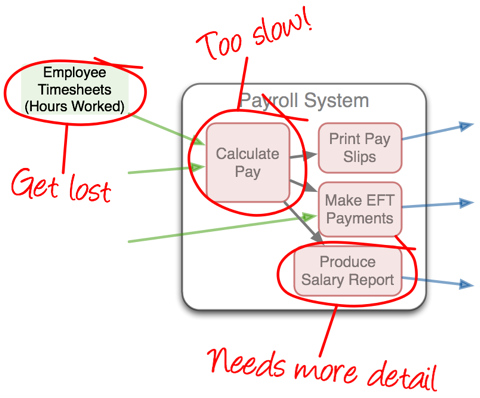
New System Requirements Specification
Now the problems with present system are understood, the system analyst can begin to plan how the new system will fix those problems.
The systems analyst specifies a list of requirements for the new system (‘requirements’ simply means targets or aims).This list is usually called the Requirements Specification.
For the payroll example the requirements might be
The systems analyst specifies a list of requirements for the new system (‘requirements’ simply means targets or aims).This list is usually called the Requirements Specification.
For the payroll example the requirements might be
- Payroll processing should be completed within 24 hours
- The recording of hours worked should use a system that means the data cannot be lost
- Management reports should contain detailed information about pay for each department, overtime payments and average hours worked by each employee
- Management reports should be electronic so that managers can analyze the data more easily
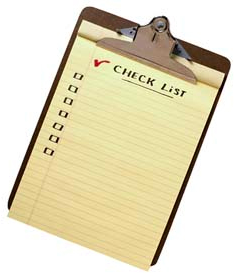
What Hardware and Software Will Be Required?
The systems analysts will now need to decide what hardware and software will be required for the new system...
Hardware
- How many computers?
- What type of network?
- How many servers?
- Any special input devices? (e.g. barcode readers)
- Any special output devices?
Software
Off-the-shelf software is software that is created for use by a large range of customers - it tends to be quite general-purpose.
Custom-written software is designed and written specifically for one customer.
Off-the-shelf software:
Custom-written software is designed and written specifically for one customer.
Off-the-shelf software:
- Cheaper
- More reliable (because most problems will have been found by one of the many users)
- Has lots of support and help available (because lots of other people are using it)
Custom-written software:
- Very expensive
- Provides exactly what the customer needs (a ‘perfect fit’)
- Only has one user, so little help is available

No comments:
Post a Comment